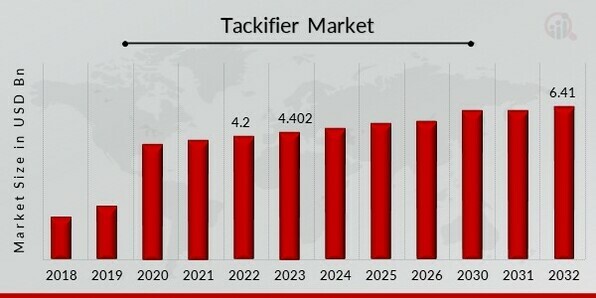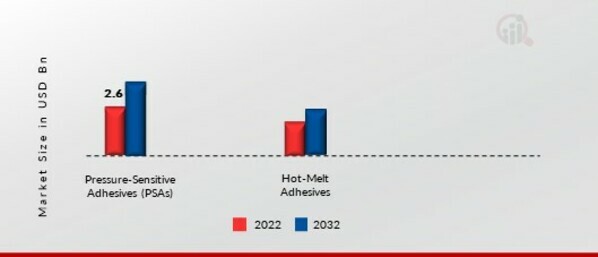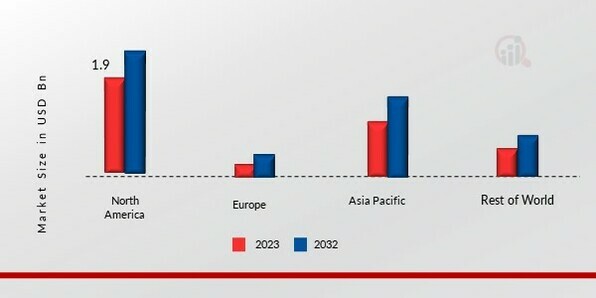Global Tackifier Market Overview
Tackifier Market Size was valued at USD 4.40 Billion in 2023. The tackifier industry is projected to grow from USD 4.61 Billion in 2024 to USD 6.4102 Billion by 2032, exhibiting a compound annual growth rate (CAGR) of 4.20% during the forecast period (2024 - 2032). The primary market driver anticipated to propel the growth of the worldwide tackifiers market is the expanding use of petrol-based resin for manufacturing PSA and HMA in the construction industry.

Source: Secondary Research, Primary Research, MRFR Database and Analyst Review
Tackifier Market Trends
-
Growing use in the automotive industry is driving the market growth
The increasing use of tackifiers in the automotive and vehicle sector is expected to lead to growth in the worldwide tackifier market. Adhesion sealants are frequently utilized in welded or joined areas between diverse structures, such as automobile bodies, construction vehicles, and civil engineering vehicles. The demand for tackifiers is anticipated to increase along with the automobile industry. The automotive industry, which was valued at USD 2.9 trillion in 2021 and may grow further due to the rise in high-income groups along with growing financial assistance creating a friendlier market for low- or medium-income groups, is being driven by a growing number of players in the automobile segment providing a variety of products ranging from affordable divides to premium segments, catering to a large segment of the consumer segment. For instance, the Ford Motor Company, a major player in the car industry, sold more than 3.9 million vehicles in 2021, including sales through distributors and dealers, according to Statista.
In addition, the packaging industry makes heavy use of tackifiers. Tackifier, for instance, is used in a variety of products, including labels, flexible packaging, cartoons, cases, and envelopes. In addition to various types of solvents, these tackifiers can be used in conjunction with tape to create airtight seals in containers. The packaging industry's increasing need for tackifiers is anticipated to fuel market CAGR.
Furthermore, in every element of residential and commercial construction, hot melt adhesives are used, namely for bonding tiles, wallboard and plasterboard, as well as for roofing, flooring and plasterboard covering. Construction activity levels have risen as a result of economic growth and rising urbanization. For instance, construction production in France climbed to 56.7% in March 2021 as opposed to a loss of -41.1% in the same month in 2020, according to the National Institute of Statistics and Economic Studies. Furthermore, in January 2022, non-residential building investment as a whole passed the $5 billion threshold for the first time since June 2020, marking a 1.5% rise, according to Statistics Canada. As building production and investments rise, hot melt adhesives will become more in demand. As a result, the tackifier is used more frequently in producing hot melt adhesives, which will accelerate the expansion of the tackifier sector.
Additionally, agriculture's tackifiers are widely used to immobilise or bind mulch materials like straw, pine needles, cellulose, or other mulch products put to seeded regions. Tackifiers are used to stop soil erosion because they stop the substance that is held to the soil's surface from moving. There may be significant potential opportunities as a result of the expanding use of tackifiers in other industries. Thus, driving the tackifier market revenue.
Tackifier Market Segment Insights
Tackifier End-use Insights
The tackifier market segmentation, based on end-use includes packaging, building & construction, rubber, paints & coatings and pulp & paper. The packaging segment dominated the market. These adhesives create flexible packaging materials like labels, envelopes, cases, and cartons. The creation of effective opening and closing settings for packaging products necessitates the employment of high-quality tackifiers, which will result in increased demand during the next years.
Tackifier Form Insights
The tackifier market segmentation, based on form, includes solid and liquid. The solid category generated the most income due to increased use of marketed tackifiers in pressure-sensitive and hot-melt adhesives.
The Eastman Chemical Company, a renowned chemical producer, brought in about $9.272 billion in sales in 2019.
Tackifier Type Insights
The tackifier market segmentation, based on type, includes natural and synthetic. The synthetic category generated the most income because petroleum resins' qualities are superior than those of natural resins. According to studies, utilizing synthetic tackifiers enhances the adhesive's overall quality; yet, the market also faces regulatory challenges from the government.
For instance, according to study papers, the performance of ethylene propylene diene polymethylene (EPDM) rubber was improved when 24 parts per hundred rubber (phr) was used.
Tackifier Application Insights
The tackifier market segmentation, based on application, includes pressure-sensitive adhesives (PSAs) and hot-melt adhesives. The pressure-sensitive adhesives (PSAs) category generated the most income. The need for pressure-sensitive adhesives is rising across a range of end-user industries, including communications, electrical and electronics, packaging, and automotive and transportation. Because they inhibit corrosion and lessen vibration, pressure-sensitive adhesives are employed to manufacture tapes and labels. During the anticipated period, pressure-sensitive adhesives will have stronger growth due to product improvements in the flexible packaging market.
Figure 1: Tackifier Market, by Application, 2022 & 2032 (USD Billion)

Source: Secondary Research, Primary Research, MRFR Database and Analyst Review
Tackifier Regional Insights
By region, the study provides market insights into North America, Europe, Asia-Pacific and Rest of the World. The North American tackifier market area will dominate this market. Tackifier demand in this region is rising as a result of the rising demand for building chemicals. The consumer's financial situation has improved as a result of ongoing economic progress, which has raised demand for textiles, buildings, cars, and electrical equipment in the area.
Further, the major countries studied in the market report are The US, Canada, German, France, the UK, Italy, Spain, China, Japan, India, Australia, South Korea, and Brazil.
Figure 2: TACKIFIER MARKET SHARE BY REGION 2022 (USD Billion)

Source: Secondary Research, Primary Research, MRFR Database and Analyst Review
Europe tackifier market accounts for the second-largest market share. The expansion of the regional market growth is projected to be aided by the rising demand for adhesives and the existence of a strong chemical sector. The usage of natural tackifiers has been encouraged by manufacturers in response to the strict government regulations on synthetic tackifiers, which has boosted regional market growth. Further, the German tackifier market held the largest market share, and the UK tackifier market was the fastest growing market in the European region
The Asia-Pacific Tackifier Market is expected to grow at the fastest CAGR from 2023 to 2032 due to rising uses in the packaging and bookbinding industries and rising demand for synthetic and natural tackifiers for use in the creation of labels and tapes. The rise in the food and beverage business, concurrent rise in the population, and high levels of product innovation could be credited with the expansion of the regional packaging industry. Moreover, China’s tackifier market held the largest market share, and the Indian tackifier market was the fastest growing market in the Asia-Pacific region.
Tackifier Key Market Players & Competitive Insights
Leading market players are investing heavily in research and development in order to expand their product lines, which will help the tackifier market, grow even more. Market participants are also undertaking a variety of strategic activities to expand their footprint, with important market developments including new product launches, contractual agreements, mergers and acquisitions, higher investments, and collaboration with other organizations. To expand and survive in a more competitive and rising market climate, tackifier industry must offer cost-effective items.
Manufacturing locally to minimize operational costs is one of the key business tactics used by manufacturers in the tackifier industry to benefit clients and increase the market sector. In recent years, the tackifier industry has offered some of the most significant advantages to market. Major players in the tackifier market attempting to increase market demand by investing in research and development operations include Arakawa Chemical Industries Ltd (Japan), Eastman Chemical Company (US), Exxon Mobil Cooperation (US), YASUHARA CHEMICAL CO. Ltd (Japan), Lawter (US), Cray Valley (France), ZEON CORPORATION (Japan), Kolon Industries Inc. (South Korea), SOLTEX (US), Foreverest Resources Ltd (China), Neville (US), Robert Kraemer GmbH & Co. KG (Germany), BASF SE (Germany), Anglxxon Chemical (China), KRATON CORPORATION (US) and LESCO CHEMICAL LIMITED (China).
Specialty chemical producers and suppliers include Eastman Chemical Co. It offers a vast array of cutting-edge materials, functional goods, specialized additives, chemicals, and fibers. Acetate yarn, specialized plastics, adhesives, performance films, chemical intermediates, and other goods are all part of its product portfolio. Wet-laid nonwovens and specialty films are also available from the company. In addition to other industries, Eastman's products are used in coatings, food and beverage, feed and agriculture, building and construction, packaging, transportation, consumables, consumer durables, and health and wellness.
Exxon Mobil Corp. is an integrated oil and gas business that searches for, develops, and produces natural gas, crude oil, and natural gas liquids. In addition to manufacturing lube base stocks and finished lubricants, it transports, trades, and distributes petroleum products in addition to carrying out crude oil refining. Along with producing and selling niche goods, ExxonMobil also produces and sells a number of commodity petrochemicals, such as olefins, aromatics, polyethylene, and polypropylene plastics.
Key Companies in the tackifier market include
- Arakawa Chemical Industries Ltd (Japan)
- Eastman Chemical Company (US)
- Exxon Mobil Cooperation (US)
- YASUHARA CHEMICAL CO. Ltd (Japan)
- Lawter (US)
- Cray Valley (France)
- ZEON CORPORATION (Japan)
- Kolon Industries Inc. (South Korea)
- SOLTEX (US)
- Foreverest Resources Ltd (China)
- Neville (US)
- Robert Kraemer GmbH & Co. KG (Germany)
- BASF SE (Germany)
- Anglxxon Chemical (China)
- KRATON CORPORATION (US)
- LESCO CHEMICAL LIMITED (China)
Tackifier Industry Developments
October 2021: Elaztobond Meltplus T8-7920, a biodegradable tackifier resin with improved adhesion qualities as well as high-temperature resistance, has been introduced by SI Group, a leading provider of technology for process solutions, chemical intermediates, performance additives, and active pharmaceutical ingredients. Without having any negative effects, the product might boost peel and tack strength by 180%.
April 2019: A light-colored tackifier called AltatacTM 1000 has been introduced by Ingevity, a supplier of high-performance carbon materials, specialised chemicals, and tailored polymers. At the Philadelphia Adhesive and Sealants Convention & Expo, the product was introduced. In addition to exhibiting high enhanced colours and stability, Altatac can give great stability in thermoplastic hot melt adhesives.
June 2023: Kraton Corporation announced that it has signed a definitive agreement to acquire the tackifier business of Michelman. This acquisition will expand Kraton's portfolio of tackifiers, which are used in a variety of applications, including adhesives, sealants, and coatings.
July 2023: Dow Inc. announced that it has launched a new line of tackifiers for the construction market. These tackifiers are designed to provide improved adhesion and performance in a variety of construction applications.
Tackifier Market Segmentation
Tackifier End-Use Outlook (USD Billion, 2018-2032)
- Packaging
- Building & Construction
- Rubber
- Paints & Coatings
- Pulp & Paper
- Others
Tackifier Form Outlook (USD Billion, 2018-2032)
Tackifier Type Outlook (USD Billion, 2018-2032)
Tackifier Application Outlook (USD Billion, 2018-2032)
- Pressure-Sensitive Adhesives (PSAs)
- Hot-Melt Adhesives
Tackifier Regional Outlook (USD Billion, 2018-2032)
- North America
- Europe
- Germany
- France
- UK
- Italy
- Spain
- Rest of Europe
- Asia-Pacific
- China
- Japan
- India
- Australia
- South Korea
- Australia
- Rest of Asia-Pacific
- Rest of the World
- Middle East
- Africa
- Latin America
| Report Attribute/Metric |
Details |
| Market Size 2023 |
USD 4.40 Billion |
| Market Size 2024 |
USD 4.61 Billion |
| Market Size 2032 |
USD 6.4102 Billion |
| Compound Annual Growth Rate (CAGR) |
4.20% (2024-2032) |
| Base Year |
2023 |
| Market Forecast Period |
2024-2032 |
| Historical Data |
2018- 2022 |
| Market Forecast Units |
Value (USD Billion) |
| Report Coverage |
Revenue Forecast, Market Competitive Landscape, Growth Factors, and Trends |
| Segments Covered |
End-use, Form, Type, Application and Region |
| Geographies Covered |
North America, Europe, Asia Pacific, and the Rest of the World |
| Countries Covered |
The US, Canada, German, France, UK, Italy, Spain, China, Japan, India, Australia, South Korea, and Brazil |
| Key Companies Profiled |
Arakawa Chemical Industries Ltd (Japan), Eastman Chemical Company (US), Exxon Mobil Cooperation (US), YASUHARA CHEMICAL CO. Ltd (Japan), Lawter (US), Cray Valley (France), ZEON CORPORATION (Japan), Kolon Industries Inc. (South Korea), SOLTEX (US), Foreverest Resources Ltd (China), Neville (US), Robert Kraemer GmbH & Co. KG (Germany), BASF SE (Germany), Anglxxon Chemical (China), KRATON CORPORATION (US) and LESCO CHEMICAL LIMITED (China) |
| Key Market Opportunities |
Growing demand for tackifiers in the paints and coatings industry |
| Key Market Dynamics |
Increasing demand for bio-based tackifiers to reduce the carbon footprint on the environment |
Tackifier Market Highlights:
Frequently Asked Questions (FAQ) :
The tackifier market size was valued at USD 4.40 Billion in 2023.
The tackifier market is projected to grow at a CAGR of 4.20% during the forecast period, 2024-2032.
North America had the largest share in the tackifier market
The key players in the tackifier market are Arakawa Chemical Industries Ltd (Japan), Eastman Chemical Company (US), Exxon Mobil Cooperation (US), YASUHARA CHEMICAL CO. Ltd (Japan), Lawter (US), Cray Valley (France), ZEON CORPORATION (Japan), Kolon Industries Inc. (South Korea), SOLTEX (US), Foreverest Resources Ltd (China), Neville (US), Robert Kraemer GmbH & Co. KG (Germany), BASF SE (Germany), Anglxxon Chemical (China), KRATON CORPORATION (US) and LESCO CHEMICAL LIMITED (China).
The synthetic category dominated the tackifier market in 2023.
The solid category had the largest share in the tackifier market.

















